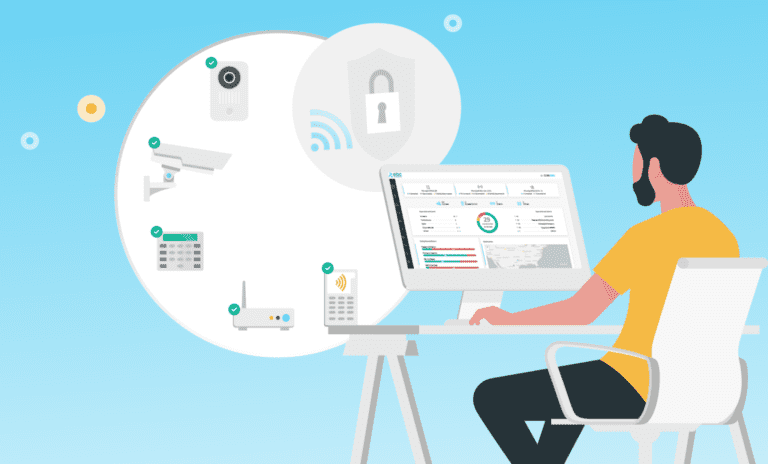It’s not hard to see why many organizations are willing to pay serious money to maintain their physical security devices. Given how reliant today’s organizations have become on connected devices to keep them safe – and given the physical and cyber risks they can face when those devices aren’t maintained properly – their are good reasons to invest in the maintenance of physical security devices.
The problem is that it’s still common for organizations to rely heavily on manual processes to maintain their devices, even though doing so is not cost-effective and often results in unnecessary, costly maintenance expenses. This, despite the fact that many maintenance tasks can actually be done remotely and in an automated way.
As a result, there is a widespread problem of overpaying to maintain connected physical security devices.
And what about your organization? Are you overpaying to maintain your physical security devices? This post will help you answer that question. If you are overpaying, there are concrete steps you can take to start cutting your costs. And if you’re not overpaying, then count yourself fortunate to work for an organization that has achieved (or is well on its way to achieving) an enterprise-ready approach to physical security device maintenance.

Manual device maintenance = unnecessary costs
If your organization is like most others, it relies on manual procedures to conduct routine maintenance steps for its physical security devices, such as rotating passwords and upgrading firmware. And many organizations check on the operational status of their physical security devices manually, rather than monitoring them automatically.
While both monitoring and routine maintenance are critically important, the manual approaches that many organizations still rely on for these steps are needlessly expensive. Simply put, if you’re paying to maintain your physical security devices without streamlining their maintenance through automation, then you’re likely overpaying.
That’s the case no matter whether you rely on your own team members or external technicians for these processes. Whether you’re paying employees or contractors, taking a manual approach to these aspects of physical security device management means you’re shelling out for professionals’ work time instead of automating these processes.
In addition, conducting these steps manually creates room for human error, which can result in unnecessary device downtime. That brings us to a second major way many organizations get stuck overpaying to maintain their connected physical security devices.
Resolving device issues inefficiently, often on-site
Device downtime is a widespread and serious risk in the world of physical security. It can occur due to a variety of issues – some of them occurring within organizations’ connected devices, and some of them occurring in related assets and systems such as a network switch, power supply, or video management system (VMS).
When you detect that some of your physical security devices have temporarily stopped working properly, it’s important to address the underlying issue as quickly as possible. The problem for today’s organizations is that it’s common to send technicians to diagnose these issues on-site and then try to resolve them manually.
If this is your approach to addressing most technical issues surrounding your physical security devices, the unfortunate reality is that you’re wasting money on unnecessary work. In fact, we have found that roughly 70% of truck rolls occur in situations in which the device downtime could be resolved by simply restarting the devices remotely.
In addition, it’s common for organizations to waste valuable work time because they don’t know whether downtime is caused by an issue within a physical security device or a related asset within the IT network. This can result in lengthy, frustrating round-robins between IT and physical security, as it’s often unclear initially which department is responsible for resolving a given issue. And a lack of efficient communication, coordination, and collaboration between physical security and IT teams (as well as other stakeholders) can result in wasted work hours.
Taking on unnecessary risks
As expensive as it can be to maintain your physical security devices manually, the price of not managing those devices properly can be much higher – and not only in terms of direct impact on dollars and cents. If you’re relying on manual processes to keep your physical security devices running consistently and securely, it’s important to beware of the possibility of human error. And without real-time alerts notifying you of technical issues that arise, the status quo could put your overall security posture at risk.
For starters, a manual approach to maintaining your physical security devices could leave you at risk of having excessive, undetected downtime. As physical security teams become increasingly dependent on their connected devices, they need to take seriously the risk that a device could be down at the time of a major security incident. That’s what happened during the 2022 shooting attack at a Brooklyn subway station, underscoring how high the stakes can be.
Additionally, relying on manual maintenance could leave your physical security devices vulnerable to cybercriminals eager to hack into them. That danger is becoming increasingly costly, with the average data breach in the U.S. now coming with a price tag of $9.48 million, according to IBM’s Cost of a Data Breach Report 2023.
It’s also important to keep in mind the legal and reputational damage that can result from a physical or cyber incident. With consumer privacy increasingly protected by law, it’s crucial to avoid scenarios that could make your customers’ sensitive information accessible to criminals.
Finally, there’s the cost of lost business that could result from a security incident or from certain types of device downtime. Various kinds of cyber and physical crimes can disrupt an organization, resulting in lost work time and lost opportunities – a risk that increases when physical security devices can’t be counted on to run properly and securely. And when connected devices such as access control systems have downtime, they can potentially leave organizations temporarily unable to open their locked doors or gates.
So, are you overpaying to maintain your physical security devices?
When looking to evaluate whether you’re overpaying to maintain your physical security devices, one strong indicator of waste is a reliance on manual processes to do things that could be automated.
If you’re paying employees or external technicians to conduct routine, proactive device maintenance manually, you could save money by automating those processes. If you typically pay for on-site, manual work to resolve technical issues that arise, you could save money by resolving many of those issues remotely, automatically, and (if relevant) in bulk.
And most importantly, if you’re counting on employees or contractors to conduct these steps manually, you’re taking the risk that human error could result in unnecessary downtime or leave you vulnerable to cybercriminals. Not only could those dangers have financial, reputational, and legal consequences for your organization – but they could put the safety of your employees, customers, and guests at risk.
So, is your own organization overpaying to maintain its physical security devices – and if it is, what can you do about it? You can start to answer these questions by taking SecuriThings’ enterprise-readiness self-assessment. Not only will it shed light on how far you’ve come toward realizing the full benefits of automation, but it will help you improve your physical security device maintenance. And if you are currently overpaying, you’ll receive valuable insights that can help you stop.




